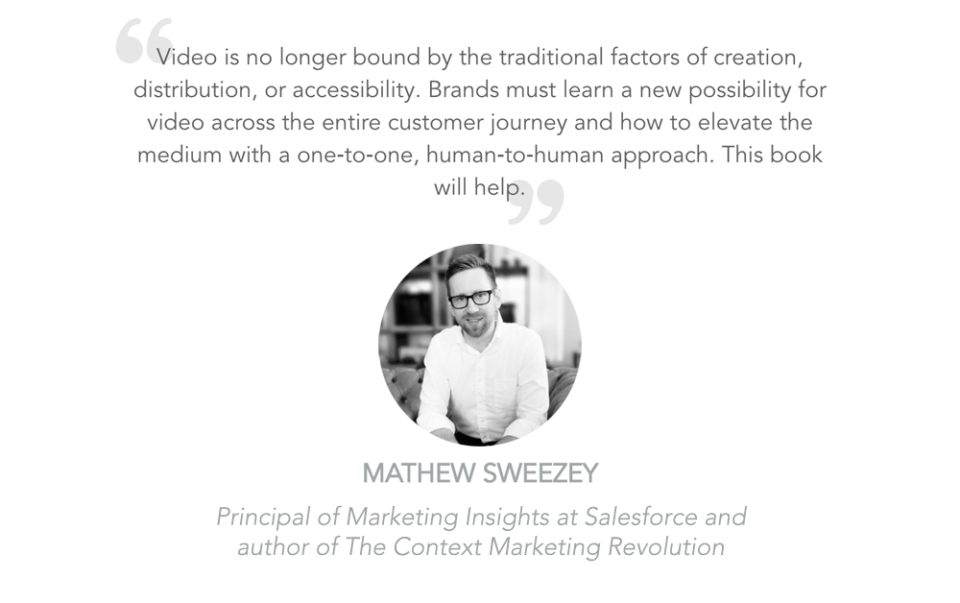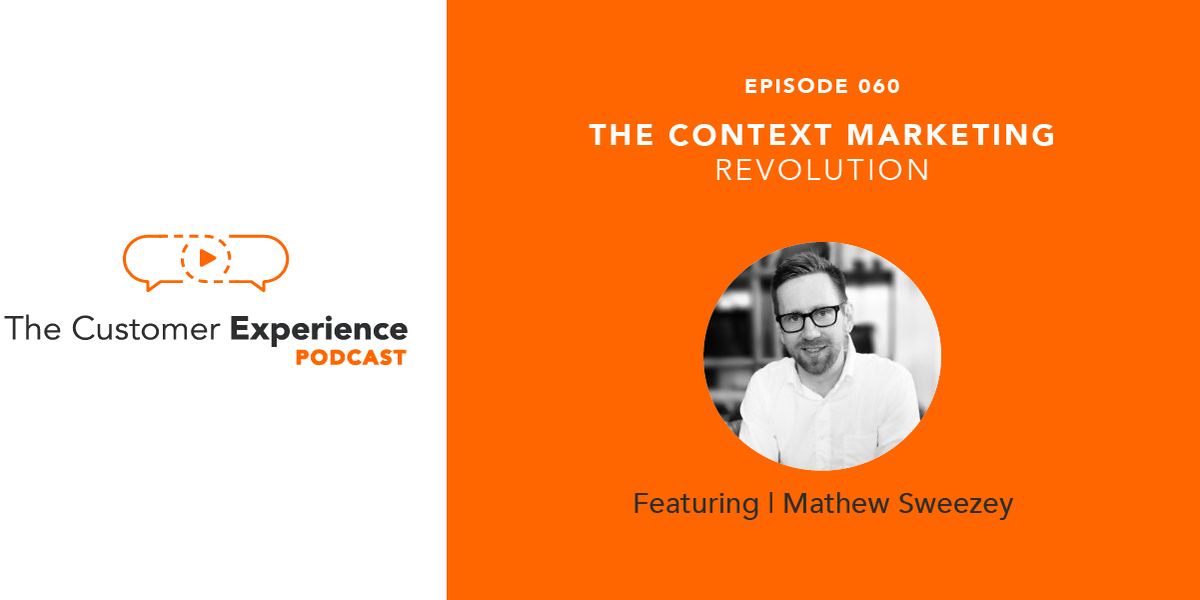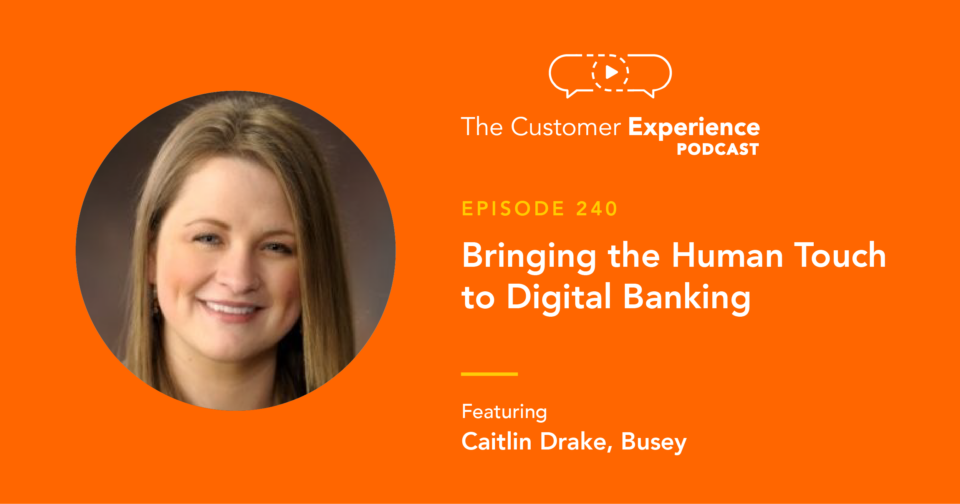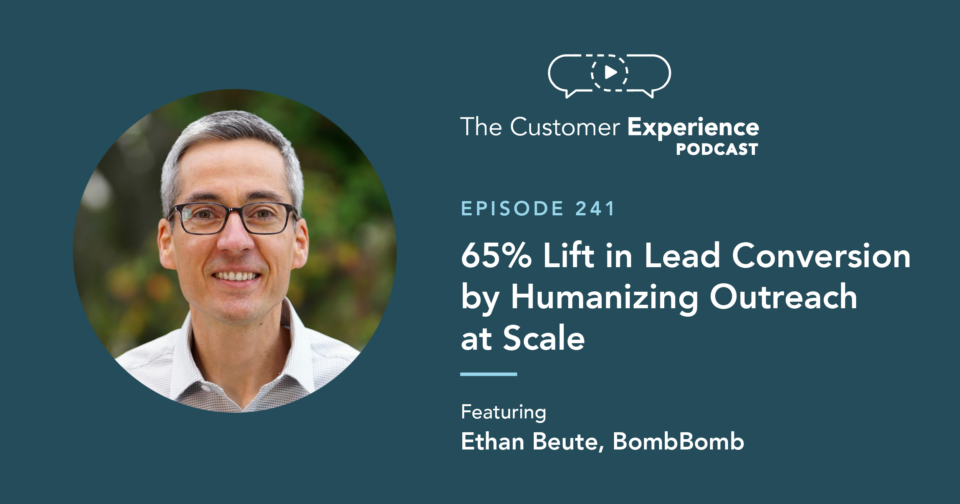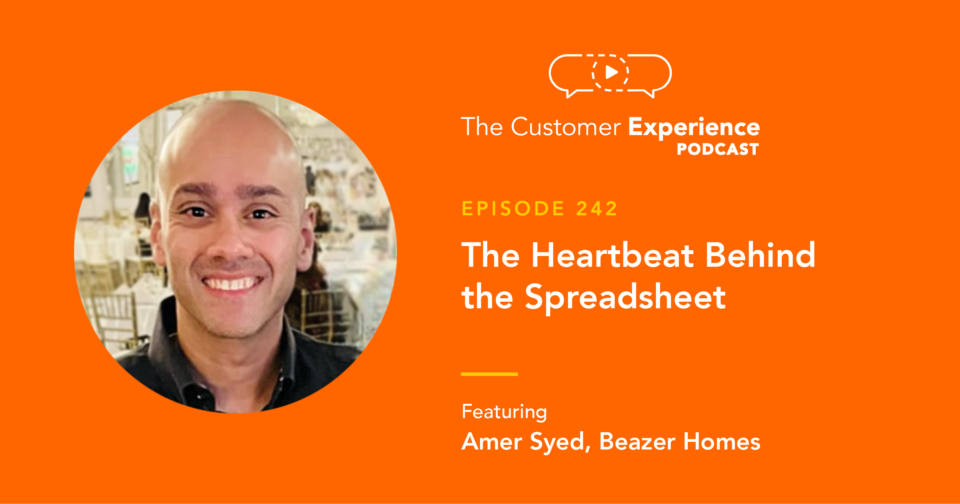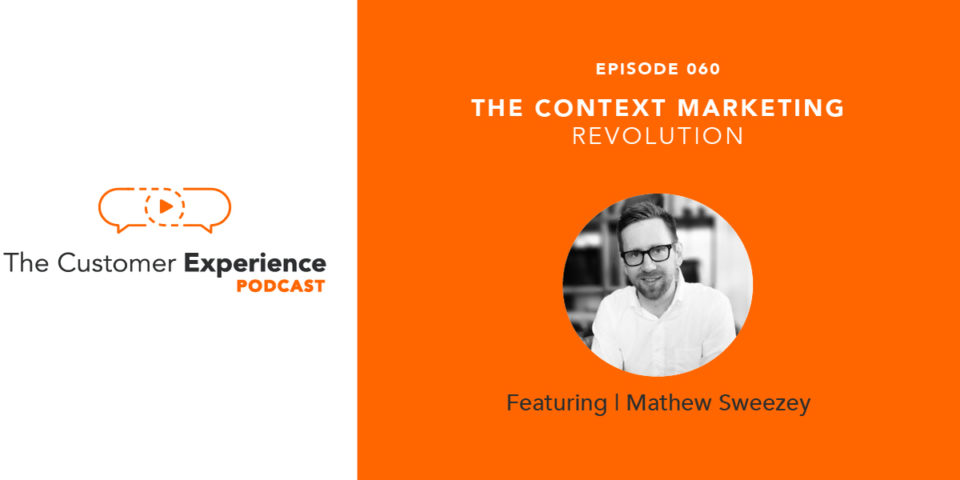
Listen to “60. The Context Marketing Revolution w/ Mathew Sweezey” on Spreaker.
Apple Podcasts | Google Podcasts | Stitcher | Spotify
If we want to be more strategic marketers, we need to ask better questions. If we want to improve, we might ask: “How can we make our marketing better?” But the answer will only get us so far.
What we really need to be asking is: “Why isn’t our marketing working?”
On this episode of The Customer Experience Podcast, you’ll understand why this is and get several approaches to the answer. The foundational idea here is that consumers just aren’t motivated in the same ways they were just 5 or 10 years ago. They want the best solution in the moment it matters most.
This is where a new approach called “context marketing” comes into play – brands reaching individuals with the right information or opportunity through the right channel at the right time.
Leading the charge into “The Context Marketing Revolution” is Mathew Sweezey, whose new book and excellent podcast series explain why iterating on our current content marketing tactics is no longer enough and how to break through the noise to connect with and better service our customers.
It’s about giving customers what Mat refers to as “The Experience”– “the sum of all the things that we do” for our customers. And we need to be doing this through our marketing because the vast majority of consumers say it’s just as important as the product or service itself.
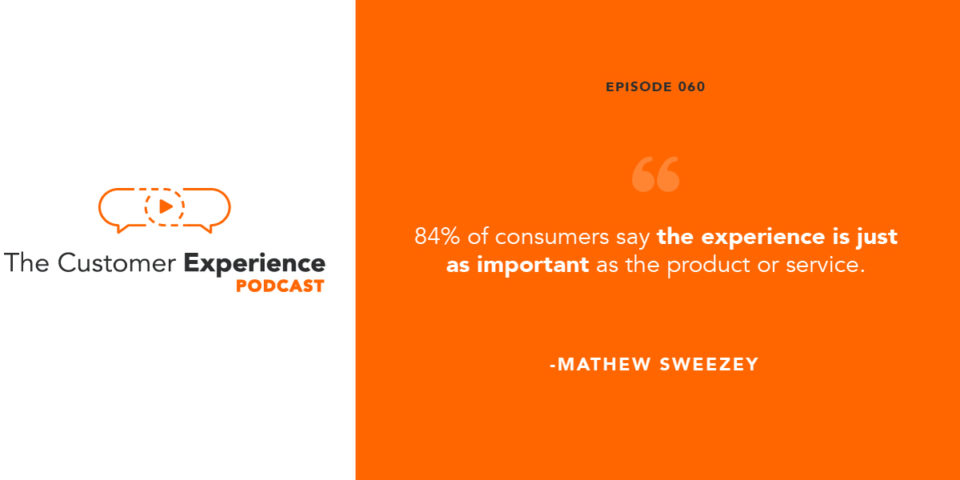
In addition to writing “The Context Marketing Revolution: How to Motivate Buyers in the Age of Infinite Media” (Harvard Business Review Press, 2020), he’s also the host and producer of the award-winning and highly-recommended podcast series, Electronic Propaganda Society.
Mat’s spent the past seven and a half years of his career at Salesforce. He initially served as an Evangelist and as Principal of Marketing Insights. And now, he’s the Director of Market Strategy.
He shares his expertise with us on this episode of The Customer Experience Podcast, as we dive into the present and future of context marketing with him. Mat shares with us:
• Why collaboration and executive buy-in makes for top content marketing performers
• Where we find the origins of The Context Marketing Revolution
• Why consumers have become immune to attention-based marketing
• How to take a more human-centered marketing approach
• Why video helps deliver a better customer experience
Listen to our entire conversation right here:
Listen to “60. The Context Marketing Revolution w/ Mathew Sweezey” on Spreaker.
For the full podcast experience, subscribe, listen, and rate/review on:
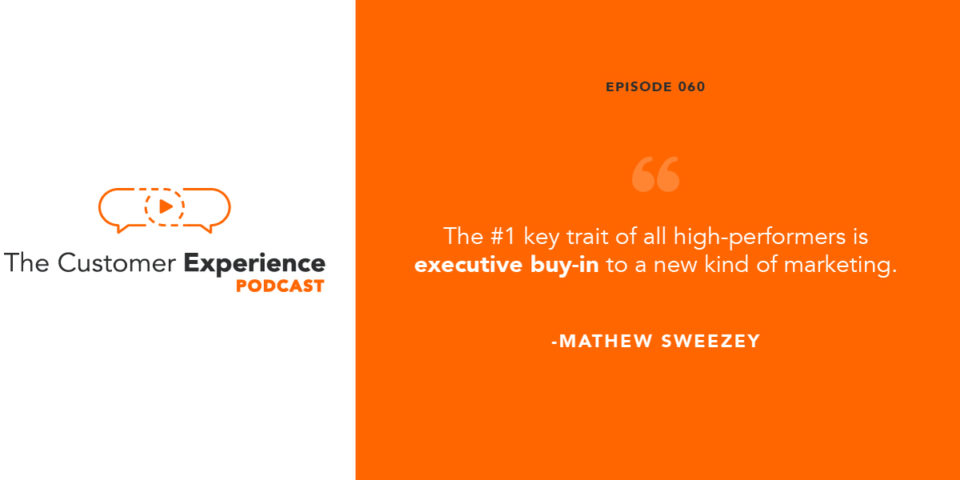
Full Transcript: The Context Marketing Revolution
Ethan Beute:
Asking how can we make our marketing better is the wrong question. Instead, we need to ask why isn’t our marketing working? When you ask why, you get much different answers. And that question and those answers are at the heart of the work being done by today’s guest. He’s been at Salesforce for seven and a half years, initially as an evangelist, and presently as principal of marketing insights. He’s the author of Marketing Automation for Dummies and the Context Marketing Revolution, a new book that I’ve already preordered, I’m really looking forward to. He’s the producer and host of the Electronic Propaganda Society, a smart, valuable, and even fun podcast series that rightfully earned a stack of awards. He’s a contributing writer for sites like Forbes, MarketingProfs and Convince & Convert. He’s a frequent keynote speaker who I finally saw speak and finally met in person at Dreamforce recently. And he’s the co-founder of a brewery. Mathew Sweezey, welcome to The Customer Experience Podcast.
Mathew Sweezey:
Thanks, Ethan, for having me.
Ethan Beute:
Yeah, really looking forward to the conversation. Before we get going, just tell me a little bit about Eventide Brewing in Atlanta. How’d that come together? What’s that look like?
Mathew Sweezey:
It’s a craft brewery that me and a few other friends started. We just celebrated our sixth anniversary beginning of this month. And yeah, so there’s just… Tagline is great, doesn’t have to be complicated, just a few friends making good beers, and we sell all across the State of Georgia.
Ethan Beute:
Awesome. I will look for it when I get down to Georgia, which I’m planning to do this summer. It’s a separate story. Let’s start where we always start on the podcast. And you have such a unique perspective on it and a well-researched perspective. But we’ll start the way I always ask it, which is your thoughts, or characteristics, or your definition of customer experience?
Mathew Sweezey:
Yes, there’s two ways to answer that question. One is it’s not up for me to define. It’s up for each of our customers to define in their own way. And I think that’s actually what the definition is. It’s what does someone perceive that they want the experience to be. And I think we understand that. And then the flip side is then how do we as a brand fulfill that? And to me, experience is always the sum of all parts. It’s not one thing. It’s the sum of everything that we do. We can use the term across the customer journey. And it’s inclusive of marketing, it’s inclusive of product experience, product use, support, service. So to me, I would put a capital T and a capital E on the experience and assume that it’s the sum of all things that we do.
Ethan Beute:
Love it. It touches on so many themes that people share, but you capture really concise fashion there. And you talked about the entire customer life cycle there. And some of the research that you’ve done with some folks at Salesforce shows that high-performing marketing organizations are 17 times better at collaborating across other departments like you mentioned, sales, service, product, etc. Talk a little bit about that research and some of the tips that come out of it. For folks who are listening, how can we collaborate better, whether you’re a marketer or not? The collaboration goes both ways. So give a little bit more context there and maybe some tips for people.
Mathew Sweezey:
Yeah, so the research. So every year at Salesforce, we do a state of marketing. And over the past five years, the focus of that effort has really been to identify the key traits between high-performing marketing organizations and everyone else. And just so everyone’s clear, these high performers are radically outperforming. They’re 10 times more likely to be significantly beating their direct competition. And then we start looking at what are those factors, like how are they actually able to do that? And as you notice, one of the larger factors is this idea of collaboration. So the number one key trait of all high performers is executive buy-in to a new idea of marketing. That’s very much in line with the definition of the experience that we just talked about. In fact, that new definition of marketing is that marketing is the owner and sustainer of all experiences, not just the creator of messages.
Mathew Sweezey:
So once that becomes the foundation, then we start tactically looking at what high performers are doing. And it takes collaboration because as we talked about “The Experience” with a capital T, capital E is across all touchpoints. And only when you have collaboration can those things then be consistent and holistic and then create the experience that is required. And when you look at very specific use cases of saying, “All right, some of these things are baffling,” it’s not a radical idea. It’s not like, “Oh, no, I never thought of that,” like, “Duh.” It’s one of those kinds of concepts. But then when we look at the actual tactical execution of how well are organizations able to execute, basic concepts of collaboration, take a simple example, let’s not market to people who are in the support queue, pretty simple. But what you might be surprised, there’s only one third of all businesses can actually do that.
Mathew Sweezey:
And it’s because the way that we’ve currently been structured as marketing as a department that sits outside, sales is its own department, support, service, product, they’re all siloed departments operating for their own goals. And I was talking to a company the other day, and I tried to go over and talk to support and said, “Can I get a list of all the people that are in the support queue so I can suppress them from this outcoming marketing email?” And the answer that the support team gave them was, “No, that’s my data. You can’t have it.” So when we face it, that’s not the only company, a lot of us face these problems.
Mathew Sweezey:
So to overcome these, it’s a couple things. One is your executives have to understand that the highest economic output that you can produce is the experience. 84% of consumers say the experience is just as important as the product or service. It is a new product that we are selling, and one might say it’s the greater of the products because it is everything and it touches all things, whereas product usage is only a small sliver of the total time. Those are some basic concepts and ideas, but just the idea of experience has to go through it, and that’s what high performers are doing. They have the executive buy-in and that then allows them to have that collaboration.
Ethan Beute:
Yeah, you really get to the… One of the main reasons I started this podcast was partly out of my own interest in this. It’s like we all get it, it’s super important, and product parody is through the roof, hypercompetition, the experience is more important than ever. And to your observation, probably the most important thing. And yet when it comes to executing, it’s really difficult because even in a healthy culture, we can start to feel siloed. So I love that you go to executive buy-in there. Just one more follow up on that. Talk about the consequences. Let’s assume that a company’s executive team is bought in on this idea that capital T, capital E, the experience is the most important thing, talk about the effect on the relationship between CMO, CRO, and CXO, chief experience officer. I know that you’ve read and spoken a bit on that. What are you seeing around these titles and the relationships between these people?
Mathew Sweezey:
Oh, yeah, acronyms. You left one off too. That was CGO, chief growth officer. So really, when we start to talk about the tactical execution of these ideas and we start to say if marketing and its old format is no longer what we are now doing, then the old executive no longer is appropriate. And so the CMO being the old executive… And actually, it’s interesting if you’ve not been in the marketing field for a while, you might not know that CMO was a pretty new term. It came out as digital came out. When digital marketing came out, that’s really when CMO comes out in the forefront. Before that, it was VP of sales and marketing for most B2B organizations, VP of marketing for other organizations.
Mathew Sweezey:
Now that we move forward, and CMO took on the roles of digital branding, advertising, all those different aspects, emails direct. Now, we start to say to the experience. And so there’s two ways to look at experience. One is you can say we’re going to focus on experience and that is just a term. The other flip side of the same coin is to say that we’re going to look at growth. So it’s either a chief experience officer or a chief growth officer that we see is driving a lot of these. We also still have the CRO, chief revenue officer, and that also could be looking at growth, just depends on how they use the definition. But really, I see one of those three formats, either chief experience, chief growth, or chief revenue officer, really being the future leader of the marketing organization because they’re focused on a holistic goal. And that holistic goal is growth by a better experience.
Mathew Sweezey:
And when you say growth, that’s the exact same word as revenue. So it doesn’t matter if you’re CRO, CGO CXO, that really is the future. But that leader… Let’s be clear on what that leader must do. And that job is to create a connected experience. They must be the one who says, “All right, we increase revenue, not by just selling more product, but by creating a better experience across the entire life cycle. It’s just as important for us to create a good service and connect that to marketing and messaging and just as much as it is to put new people into the pipeline and service them all the way through. So, yes, I think all three of those are accurate, and it doesn’t matter which one you choose, it just matters that you have the executive buy-in to be inclusive and be a bridge builder between all experiences to make sure they’re consistent and holistic. And that’s the new pathway to grow.
Ethan Beute:
Love it. I’m going to give you a couple of your own quotes and ask you one follow up before we get onto the Context Marketing Revolution. New book, Harvard Business Press, right?
Mathew Sweezey:
Yup.
Ethan Beute:
I might ask about that relationship too because that’s cool publisher. But before we do, just a couple of quotes of yours, “Marketing creates experiences, not messages.” “Your brand isn’t what you say, it’s the sum of all experiences you create.” I think you’ve already touched on some of these themes already. Just because there’s been a background thing as I’ve been talking with a variety of people in a variety of seats in a conversation like the one we’re having now, talk about your view of brand experience and customer experience. Are they synonymous? Are they unique, or is it just semantic and you don’t even care, it’s not interesting to you?
Mathew Sweezey:
I’m more on the second of it’s just semantics because what is brand? Well, brand is the sum of all experiences. And if that’s what we define as brand… And then how you tactically execute those could be different things, is the tactical execution, is the goal of the marketing to drive and engage and move the person forward into a customer journey. That’s much going to be much more of a customer experience marketing initiative. Whereas what if the goal is just to make sure people are aware of us, know who we are, that’s much more of a traditional brand, i.e., just becoming aware of who we are and what our mission and what our ideas are. So to me, they’re both the exact same thing because I believe brand is the sum of all experiences that you create.
Mathew Sweezey:
And the reason I say that is because you can tell the world all the messages… You can say, “This is who we are.” You can put all the pretty pictures up. You can just have the best coffee and best advertising in the world, that’s branding. But as soon as they interact with you in any way, shape or form, if that’s not consistent with the message or the projection of the expectation that you’ve set, then you don’t have a brand because the sum is they found something radically different and now they feel lied to, hence you now have a very bad brand. So to me, it’s the latter. It’s the sum of all experiences and they’re really the same thing to me.
Ethan Beute:
Yup, good. And it’s not just that it can go terribly bad, to that disconnect, just plain create confusion, not even… oh, which of course is a negative sentiment as well. So the Context Marketing Revolution, how to motivate buyers in the age of infinite media, full title of the book, this’ll be released I think a little bit before the book is finally released.
Mathew Sweezey:
March.
Ethan Beute:
Yeah, this episode will be a little bit before it. Before we get into some of the themes and topics, when did you know that this was a book that you wanted to write? Because you’re studying these things, you’re talking about them, you’re teaching them, etc., when did you say, “I need to round this up and put it in a book”?
Mathew Sweezey:
Yeah, so I don’t know when that was. I think it probably came down to when I was doing the research and just… So I’m always constantly researching topics and researching things. And one of the things I was trying to research was what is the cost of marketing going to be in the future? And when I started to look at that, that required me to say, “All right, what is the cost to break through the noise?” And said that one more step was we now need to start measuring the noise. So I started measuring noise from 1900, all the way through and projected to 2030 as best as I could. And then when I started to find out was how we started to think about these things and the environments that marketing is taking place in are radically different from a media theory level.
Mathew Sweezey:
And so once I started to realize that and realize that the iterations that we continue to iterate upon were specific games that were created for a specific environment and that no longer is true, that’s really when I decided that, “All right, this is big. We need to really think about this and focus on this because this is not an iteration on old marketing ideas.” Iterating on old ideas will not carry us forward into the future. Back to the quote you opened up with, if we asked how do we be better, we simply take the ideas and foundations and iterate upon them. Well, if the foundational ideas are no longer correct, we’re iterating upon something and creating something bad. So we have to question those foundations. And I think when I realized and did the research on noise and found that we entered a new media environment, that’s really when I decided that “Hey, this is important. We should talk about this.”
Ethan Beute:
Cool. Since I have not read the book, I think one way to get at it is through the title and we’re right on the doorstep of this one. Talk about what you mean by infinite media and what are its consequences because that really is the crux of a lot of this.
Mathew Sweezey:
Yeah, totally. So, infinite media. So if we follow media theory, which is really spearheaded by Marshall McLuhan, Harold Innis, Neil Postman, it’s essentially a theory that says human behavior is dictated by the media environment that surround them. And when we think about media environment, it’s not Twitter, social media, it’s something much greater. Just like the basic concepts of how the printing press took the world out of the dark ages and into the age of enlightenment. So infinite media is in contrast to limited media. And before 2009, based on my mathematics, that was the limited media environment, and that meant three specific things. Media was limited in terms of creation, in terms of distribution, in terms of full consumption. So when those three things are limited, that’s a very specific environment, and we play a very specific game within that environment.
Mathew Sweezey:
And if you look at who had access to overcome any one of those barriers, it required capital. So predominantly, noise was created by businesses and it was a monopoly. And then after 2009, what we find is that the individuals creating their own media on social media, on email, and as well as their devices, they now are the largest creators of noise since noise is very different. And also, it follows a very different pattern, where they continue to create more and more and more and for more players. So we see an infinite level of noise rising. There’s no barriers to creation, there’s no barriers to distribution, and there’s an infinite amount of content available for access. What this really means is that consumers now operate in a different world, and they have different decision-making tools, and they have different decision-making processes.
Mathew Sweezey:
So the way that marketing was rehearsed and crafted was to say, “We are here to motivate individuals given a specific set of circumstances of how they make decisions.” What I’m arguing for is saying, “All right, consumers now have a radically different decision-making process. And the role of marketing now is radically different, which must match that process based on the environment.” So longer short, infinite media means that now consumers are in control, and how we motivate them is not by grant copy or single advertising campaigns where we said something so creative, we got them to take action, rather we must understand that these things now take place across a long series. Everything is a journey and motivation is done by guiding individuals, by step-by-step across that journey, not by trying to get them to skip steps. So it’s pretty much the basis.
Ethan Beute:
Yup, it makes perfect sense. And just to tie it back for people that haven’t tied it back in their own heads already, that is why this iterative approach as how do we make it better does not apply because we’re just building on old blocks. It’s funny. I remember reading a book. It’s called Scientific Advertising. It was either a thin book or just a really amazing pamphlet that’s decades and decades old. And it’s basically so much when I think about a lot of digital advertising right now and the iterative approach, we can do AB tests faster, but essentially it’s the same thing this guy was writing about in direct mail and magazine ads decades and decades and decades ago. So we feel like we’re so well-equipped in the pace of things fast, but still it’s an iterative approach nonetheless.
Ethan Beute:
Let’s go to the front side of the title of the book, the Context Marketing Revolution. I think revolution is already baked in. I think anyone that’s listening to what you’re talking about and the consequences of the age of infinite media sees that this is revolutionary. But talk a little bit about context marketing. What is context in this context?
Mathew Sweezey:
Yeah. Sure, yeah. So context is… Once again, it’s in contrast to something, it’s in contrast to the word attention. So the foundation of marketing and the limited media era was how do we break through grab someone’s attention and get them to do what we want. That was how we motivated people to action. Now, what we see is we motivate people by context, and that really has a couple of factors. One, saying that with infinite media, we now have an intermediary between brands and individuals. That intermediary is artificial intelligence.
Mathew Sweezey:
Well, AI is only going to let through what is contextual to that individual to the moment because that’s what generates the highest engagement. And you can see, look at any social feed, look at anything that’s mediated by digital, by AI, and you will see it’s the contextual feed. Your Google search results, the results are specific to you and the context of you in that moment. If you look at social media, that feed is a contextual feed, not a chronological feed. Now, you look at your email inbox, list goes on and on and on.
Mathew Sweezey:
So number one, for marketing to break through, it has to be in context of the moment. That’s key number one for context. Key number two is that context also means what does it mean to the individual? So we got on this big kick of content marketing. All we need to do is create content. But the problem is no individual ever said, “Damn, I want content today.” So what they want is they want something that’s contextual to help them solve a goal. That’s really the definition of the tactical execution of context is how do we help the individual solve the goal of the moment? And by helping them accomplish that goal, we build the trust we need.
Mathew Sweezey:
And it doesn’t matter where it is, we break through because we can help them with that moment. We then build the trust we need, and then we’re able to leverage that moment to guide them to the next step. And by doing that, we then are able to then generate the demand by guiding people by saying, “We’re going to take this and keep you going down this path,” and then that’s the basic concept. So that’s really the concept of context in the contrast to attention.
Ethan Beute:
Awesome. For folks who are listening, normally we would wait to the end of the episode, but I’ll just go ahead and say it for you. The Context Marketing Revolution is available for preorder. You can preorder it on Amazon. That’s what I did. If you like these ideas… And I’ll transition, we can get a preview of a lot of these ideas too in a really cool format. But really quickly, now, did you build a proposal and shop it to different publishers? How’d you get connected with Harvard Business?
Mathew Sweezey:
Yeah, so I wrote an outline, wrote a draft, and then pitched it to a bunch of different publishers. So I had three publishers willing to publish it. And when Harvard’s one of them, Harvard Business, who doesn’t dream of being published by Harvard Business? So I was like, “Sure, let’s have you guys publish it.” That’s how it happened.
Ethan Beute:
Awesome. Congratulations. For people who like these ideas and are in anticipation of the book itself, I want to offer that you can go to iTunes, or Apple podcasts, or wherever you listen to podcasts, wherever you listen to The Customer Experience Podcast, and go search Electronic Propaganda Society, award-winning series, incredibly well produced. Unlike this one and so many other podcasts, it’s not interview-based. It lays out all of these theories and ideas and research over nine episodes. And so I guess just to open it up on the Electronic Propaganda Society, what were you trying to deliver in terms of experience? Why the audio format and why the style of production maybe?
Mathew Sweezey:
Yeah, a couple of reasons. One, I’m a creator, just I think most of us are. And I wanted to create something rad, just pure passion project, no bounds, see how far it can push, and see how radically creative I can be with something. And so I’ve created that format. So it’s not a traditional podcast, it’s not interview-based. I based it very much off serial. So it’s a nine series episode that tells a single story, and then it’s heavily researched, heavily produced, just because I wanted to do it that way, and I thought that would make a good experience and make something that people would enjoy. It’s very different than anything that’s out there. It’s why I won so many creative awards for it when it came out. So I believe I’ve got five creative awards for it currently. But yes, that was it. And it’s super rad, and it’s something you’ve never heard before. And that was the point.
Ethan Beute:
I agree completely. And it really does tee up all the stuff we’ve been talking about so far. I love it as a compliment to having seen you present on some of these topics and in anticipation of the forthcoming book. There obviously are a lot of connections between them. What were some of your inspirations? Are you a podcast listener, or what were some of your inspirations as you’re trying to create something that was awesome for you?
Mathew Sweezey:
So I don’t listen to many podcasts. I think I’ve listened to two. I think I made it almost all the way through serial. But I think just radical formats of content, a great documentary, a great docuseries, and I just figured that it was easier to do via podcast than any other format. So I did it via the podcast. For inspiration, definitely serial. I reached out to a friend of mine who’s a producer at W… Whenever the public radio station is in New York, my brain stopped. But read some books, Sound Reporting that was written by NPR, so just audio, how to do those things. But really just listened to podcasts and just really go listen to top rated podcasts and been listening to what I believe made them top rated and then just mimics that. So it wasn’t like some crazy thing. And then really, the theme was ’50s and ’60s Soviet era propaganda. And so that it was like the underlying artistic theme for this, hence the revolution and that was the visual format. So trying to put the balance.
Ethan Beute:
Yeah, you’ll know you found the right podcast when you see some of that era artwork. The whole theme is really well-developed. Obviously, you drew in a ton of… To me, one of the most impressive things from a production standpoint was how much original audio you brought into it, clips and quotes and speeches and the Knight Rider theme song in historical clips and fun edited stuff. But you also referenced several books that I just really love and respect and I’m just going to name a handful of them, The Cluetrain Manifesto you leaned on, The Experience Economy by Pine and Gilmore. They have a new one out recently, the medium is the message from McLuhan, who you already referenced, Permission Marketing from Seth Godin, which was very fundamental to us at BombBomb as we started getting going, and one of my personal favorite books of all times, Small Is Beautiful by E. F. Schumacher.
Mathew Sweezey:
One of mine too.
Ethan Beute:
Yeah, are you a prolific reader? If I mentioned those books and people liked a couple of them, what are some other favorites that you’ve got?
Mathew Sweezey:
So first off, I don’t know if I’d consider myself prolific. I consider myself a follower of rabbit holes. So when there’s a question in my head, I try to then go research and follow that rabbit hole until it’s exhausted. And what that really ends up with is me going down very archaic different paths and finding random authors, little books, or big books that are on that topic. So it’s really how I come across all of those. And then in conversation of, “Hey, I read this with a friend.” “Oh, well, then have you read this? It’s very organic how I find them.” And so I wouldn’t consider myself necessarily prolific.
Mathew Sweezey:
I have read a lot just based on the work I do and those rabbit holes and making sure I… The reason I do that is not because I’m a prolific reader, it’s more or less because I’m insecure. And I think the insecurity is I never want to be on stage and say something and have someone say, “That’s wrong because you never read this book.” And in this book, he argues against that point. So I wanted to make sure that I had a theoretical foundation that I knew anything that was going to come at me, and I think that was the reason I read. I wouldn’t say I’m a prolific reader, I just say. I did for those reasons.
Mathew Sweezey:
The second on other books that people may enjoy, it’s such a hard question to answer. And there’s so many books that I read from so many different things. And it’s like, “Do you want a historical context?” It’s like, “All right, we talked about feedback loops,” but it’s like, “Did you ever really read the original book, which is Robert… It’s right behind me, somewhere around here. There’s original books by… I don’t remember, I can’t pronounce the last name. He talked about feedback loops back in the ’50s, and that was really the foundational aspect of intel and all those concepts.
Mathew Sweezey:
And we talked about The Experience Economy, Joseph Pine, Jim Gilmore, foundational to that theory on Doc Searls, one of the coauthors of Cluetrain Manifesto is got a bunch of other books. Seth Godin’s got a bunch of other books. And it just depends on how nerdy or how tactical or how practical you want to be with book recommendation. And there’s so many good books out there, that’s just so hard. But if I could just take a second to talk about what you said was your favorite and my favorite, which is E. F. Schumacher’s Small Is Beautiful. So pretty much I’ve seen through the majority of my favorite books is this constant theme of humanity. E. F. Schumacher talks about… And there’s lots of quotes I use. And one is that industry is so great, but it’s so inefficient to a degree that we don’t really realize its inefficiency, hence we just let it continue being inefficient.
Mathew Sweezey:
But if we start to look at these things and say, “All right, if we put humans at the center of everything, if we put humans at the center of our business, if we put humans at the center of what marketing should be, if we put humans in the center of economics, we see a very different approach.” And on that note, if you haven’t read the book, Aldous Huxley the Island, I would say make sure you read Aldous Huxley the Island. It’s not a marketing book. It’s totally a book about humanity and about what if we thought about living in a different way? But I think that’s my favorite thing through all those books is it’s just a challenge.
Mathew Sweezey:
And I can’t say enough about Schumacher’s theories of what if we thought about economics not as the highest financial return, but as the highest stakeholder theory return, which is essentially what he talks about way before stakeholder theory became a thing. And that then leads you into purpose-driven business, purpose-driven marketing. I do believe purpose is a massive powerful force. And all of our marketing in the future must have an element of purpose in it, just because it focuses us on conversations past our product. And so it allows us to have a more human relationship, a more honest relationship past just the product with our audience in our marketplace. I don’t know if I answered your question. That was a-
Ethan Beute:
No, man, that was a great, great pass. The subtitle of Smell Is Beautiful’s economics says if people mattered. And I love the way you captured it and summarized it there. And I agree with you on purpose. I see it more and more often. I think it’s one of the big consumer packaged goods. Conglomerates was talking about how they’re going to start folding some of their brands if they can’t identify an authentic purpose that transcends like paper towels, or toothbrushes, or whatever else they’re selling. They’re going to start peeling off some of the brands and putting them off to market because purpose matters so much. I think it does. I’m probably abusing the word context here, but I think that purpose gives people some context for their participation with you and your product or your service.
Ethan Beute:
And I just advocate and I’m sure you would too is that it is sincere is a big deal I think when you think about a lot of the shallow surface layer, flimsy purpose stuff that people just staple up over the front of the store, storefront, or whatever as a concept falls away really quickly. And so it needs to be sincere and authentic to the core of the business. I think it’s one of the things for us here at BombBomb. We’re very clear on what we trying to do in the world and the way that we wanted to operate from the beginning. I don’t that it has bled through as much to our customers as much as maybe it could, should, would in the future. But I think having it early and having it be clear and shared is a really big deal. Purpose is a thing.
Ethan Beute:
We could probably do 20 minutes on purpose, but I’m going to try to let you get back to your date, or just a little bit, I got a couple other topics for you. One of them you were kind enough to review and say some nice things about a book that I coauthored with Steve Pacinelli, my good friend and team member here. It’s called Rehumanize Your Business. I think it does what you were talking about, which is we tried to put the human at the center of video in particular. And so I’d just love for you to share your thoughts. And I saw you put up a LinkedIn post recently about increased consumption of video projected into the future. Talk a little bit about one-to-one video, this human-to-human video, as well as just video in general. Anything you got on video, I’d love to hear it.
Mathew Sweezey:
So, yeah, I posted this morning actually. So doing my research on my 20 future of marketing 2020, put out a future of every year about marketing. And one of the big things is just going out about five years, what we need to be really cognizant of is 5G and more free time. So one of the things is as 5G comes about and as we start to offload more things to IoT, we’re going to start to open up more free time. We’ve opened for free time every year since digital is become a thing. It’s going to come even greater. So I talked about if we go 5 to 10 out and we start to get into these self-driving cars, well, what do we then do with two hours of free time every day?
Mathew Sweezey:
Well, we’re going to consume content. And one of the most consumable pieces of content with 5G will be video. And as we start looking at how’s that going to break down short form, long form, live video, and then you talk about one-to-one. So one-to-one to me… And I’ve gotten some flack from this, but to me, one-to-one was an idea of one brand creating one message for one individual. But I think we need to really think about is human-to-human. How do we connect one human to another human and do so at scale? And the definition of personal for me in the future, is it personalized? It’s not how customized can I make a massive experience to an individual, it’s how human can I deliver that? How personal can I deliver that experience?
Mathew Sweezey:
So if it is one individual creating a video and sending it to another, that is one piece for one individual, that’s is one human talking to another, instantly consumable, instantly engaging. Yeah, and I think it’s going to be a new format. It is a new format already. Video is very engaging, we videos. So all Pro One Video, have been for a long time. And I think as time moves on, we’re going to use video more and more, just because it’s easy.
Ethan Beute:
Yeah, I love that you draw-
Mathew Sweezey:
Engaging.
Ethan Beute:
… the distinction between one-to-one and human-to-human, or this idea that because it speaks to you and I love that you use the language around pers… The line that I drew, I wrote a blog post maybe two or three years ago about personal versus personalized in the context of video. And this idea that, to me, personalized is dear first name because you action with product name. Yeah, yeah, it’s just variable stuff versus truly personal is, “Hey, man, I just so appreciate your time.” In our conversation today, you made me think about this thing that I had read about. I’d read your work on it, I’d heard you speak about it, but I think about it completely differently now. I just so value it.
Ethan Beute:
This truly personal experience is not a variable data slug. And it’s interesting because the other background theme on it is scalable versus unscalable. I think a lot of people look at it and they say, “Oh, this doesn’t scale. And then it begs your original question, is it better? If we could make it slightly incrementally better by inserting better variables into these things versus can you create a truly personal experience? And what is the value of that, especially in the face of all this noise?
Mathew Sweezey:
Yeah, no, and I totally agree. And scale is the big thing. So one of the foundational elements is the technological foundation for context marketing for all marketing in the future. Without technology, there is no way to scale these concepts or ideas. With technology, we know exactly who to talk to, what human connect with them, whether that’s an employee, an advocate, a salesperson, a marketer. We know exactly who to connect, what conversation to have, and then how to guide them to the next steps. And it becomes a scalable system, where marketing is no longer we sitting in boardrooms, coming up with campaigns to push to the masses, rather we create webs of systematic automations, and we manage these automations which are connecting us. And that’s making the best use of our time.
Mathew Sweezey:
And I think that’s the biggest thing. And we haven’t talked about this one word of agile. That’s the other aspect of scale. And so it’s the technological aspect of what does it take technically to scale. There’s the other of what changes do our processes have to take on? Well, we have to take all new building processes. And I think that this is one of the things I love to talk about is the concept of we were all trained on the assembly line. 1912, 1918 Henry Ford comes out with the assembly line, and that’s how we think about building. That’s how we structure our organizations and silo organizations, the building process, or the waterfall process or an extrapolation of the assembly line.
Mathew Sweezey:
But now, we have instant feedback. And so we must move to a new model, which is agile, which is rapid testing. Listen to Morgan Brown, Sean Ellis, growth hacking, it’s rapid innovation. This is what we’re talking. And so I think that’s the other aspect of scale. It’s in those two combinations, have to happen together, and then these things become possible. Then we’re no longer saying, “All right, how do we just create the right message to the right person at the right time? How do we connect the right human to produce the correct experience and context for that moment.” And I think that’s where we have to go.
Ethan Beute:
I love it. It’s just bridging it to the truly personal moments. It’s using technology and processes to put people to be in their best position to be of highest value, doing things that machines can’t do. And you let the machines do all the things that machines do best. Salesforce, you’ve been there for quite a while, you started as an evangelist, you’re principal of marketing insights, what is your day-to-day, week-to-week, month-to-month relationship to the Salesforce mothership? How do you plug in? Are you just a man about the world, whose work is supported by Salesforce? What’s the working relationship there? It’s a cool job, you have an awesome job by the way.
Mathew Sweezey:
Yeah, yeah, totally. I agree. Thank you. Yeah, so I actually started out in sales for a little startup called Pardot. And I was the second salesperson, employee 13. We grew that company up, and we got acquired by ExactTarget, then acquired by Salesforce. I transitioned into the thought leadership role during that process. Just to get that decided, I really was passionate about. And so plugging in. So I really am utilizing a couple of different ways as a lot of us are utilized. It’s customer meetings. It’s going and talking with large brands, talking about what their future looks like, giving a presentation to them, doing customer dinners, helping with research, as well as then third party speaking engagements and evangelizing the brand on stage all across the world. So people really see us as, “Hey, they’re not just the technology provider, they’re also someone who is at the forefront of the field that they’re upselling to,” so that we can produce far future leading thoughts and help guide our businesses forward, not just by the technology that we create, but also the theory that they need to utilize to succeed with.
Ethan Beute:
Yeah, I was in a session at Dreamforce with a couple of researchers who were working on essentially future of work, which made me think about you and how many of you in different topic areas are there inside an organization like Salesforce.
Mathew Sweezey:
It’s hard to count. When you start getting into… I have a team, I sit on the market strategy team, so I’m not tied to an actual cloud product. I’m a side separate entity. But then each products have their own evangelists, have their own research. So we have it very distributed across the organization. But all my team, there’s probably about 10 of us, each has a different role. So IoT, future of work, voice of the customer, sales and marketing. You’ve got a bunch of different ones that have rolled up into. And I really focus on the future of marketing.
Ethan Beute:
Awesome. And it shows you’re doing a lot of great work around. It’s really fun and interesting. Last question, another LinkedIn post of yours. This is just interesting to me and highly consequential and it seems very relevant to people who maybe haven’t noticed. But you noted that Chrome is planning to kill off third-party cookies by 2022. What do you think is the motivation and what are the implications?
Mathew Sweezey:
Oh, the motivation is easy. If they don’t do it, there’s going to be government regulation that’s going to regulate them to do it anyways. So they’re just trying to get ahead of the boat. So that’s why they’re doing it, individual privacy, customer privacy. Third-party cookies really aren’t great for individual privacy. And a lot of the people who created the internet believe that they’ve run amuck, and we’ve used them to really do the consumer a disservice. So pretty much everyone’s going away with them. So five years out, we should really be thinking about a post third-party cookie world. That doesn’t mean posts first and second, it means post-third.
Mathew Sweezey:
So we’re going to have to figure out new ways of attribution, new ways of reporting, new ways of tracking, new ways of engagement. But the good news is that as long as… A lot of those things were just for third-party advertising, programmatic ad buys, retargeting, and then the attribution of those things. So we’re just going to be a new world. And I think that’s really when if you double down on context in that notion, move past just I can push button and advertise to anybody, so now we need to really focus on how do we connect one human to another human and do so in first and second party ways.
Mathew Sweezey:
We’re really going to build a much stronger, more durable brand with better data that’s regulation proof, zero first and second party data is regulation proof. So we have permission to use that, which once again puts permission at the forefront. When we do ask for permission, we build a different type of trust, we build a deeper trust with our individuals, and it helps us break through. Yeah, so it’s a pro and a con. So we’re not going to be able to do the same things they used to do, but I think it will be better for everybody moving forward.
Ethan Beute:
Yeah, so good. I just had a flash there of how long ago Seth Godin’s Permission Marketing was written, but how far we have not come in some ways against it, just the spirit of it in general. And so it’s interesting as I think about good brands and good product services and experiences, a lot of it comes down to being a great human being that other people want to be around. It’s like those qualities are the qualities you want to provide such that people are attracted to you, and they feel good around you, and they feel good about themselves. And yeah, it’s good. Thanks for that passage.
Ethan Beute:
Hey, man, this has been awesome. I really appreciate the work that you’re doing. I enjoy you personally. And before we go, I want to give you the chance to bring to life one of our core values here at BombBomb, which is relationships. And so I’d like to give you the chance to thank or mention someone who’s had a positive impact on your life or career and to give a nod to a brand or a company that you really appreciate for the experience they provide for you as a customer.
Mathew Sweezey:
All right. Yeah, so first, I’d like to give a shout out to Doc Searls. You mentioned him earlier off the Cluetrain Manifesto. Doc is definitely been very helpful, either reach out to is definitely helped guide me. Helped a lot with the book in terms of just questions, and just someone that’s been great. I love the work that he produces. He’s an awesome human, and he’s definitely helped me out a lot. So shout out to Doc.
Mathew Sweezey:
And then a company I highly respect and I think create a great customer experience for me as well as others is Wistia. They’re probably one of my favorites. I’ve known them personally for going on 10 years. I’ll always love the individuals that they hire, the culture that they put together, the marketing that they put out, the software that they create, and the experience just in general of everything that they do. It’s very unique, very specific. And it’s a great example of how culture and how leadership really does create a culture. And if it’s not at the executive level, it’s very difficult to create such a positive and unique culture inside an organization if the executives don’t have it. So I’ll go with those two.
Ethan Beute:
Awesome. And that’s a reflection of another background theme on the show, which is that a great employee experience begets or is a necessary precursor to a great customer experience. And culture is one of the words that capture some of that essence. We already talked about preordering the Context Marketing Revolution on Amazon. I mentioned you’re someone great to follow on LinkedIn. How else could someone follow up with you and your work if people enjoyed this conversation, they liked the ideas, they want to go deeper, where would you send people?
Mathew Sweezey:
Yeah, so two things. One is make sure you either follow me on LinkedIn or Twitter. I publish there on a pretty weekly basis. If you haven’t listened to the podcast and want to get a jump on what the book talks about, I’d say make sure you listen to the Electronic Propaganda Society, and then definitely please preorder the book. I think you’ll enjoy it. And really, the goal is to really help marketers… not necessarily help marketers as much, but help marketers make the case to their executives of why we must change and go down this different path. And that’s really the focus of the book is to help you have the fire power to make these changes internally in your organization.
Ethan Beute:
Really good, because it’s big, it’s scary, it’s revolutionary. And so I think being better informed, better equipped to make these arguments and to make these observations internally, and even collaborating across teams and building consensus around some of these ideas, so I hope the book delivers on your mission because I think we’ll be enjoying our lives and businesses a little bit more when we start moving more in that direction. Thanks so much for your time today, Mat. Really, really enjoyed it and hope you have a great week.
Mathew Sweezey:
Awesome. Thanks so much for the chance.
Video Highlights from “The Context Marketing Revolution”
Check out the top five video highlights from the entire chat with Mathew on context marketing below…
1. Collaboration and Executive Buy-In for Top Marketing Performance
2. The Origins of the “Context Marketing Revolution”
3. Context Marketing vs Attention-Based Marketing
4. Taking a More Human-Centered Approach to Marketing
5. Using Video For A Better Customer Experience
Books Mentioned In This Episode
- Small Is Beautiful: Economics As If People Mattered by EF Schumacher
- The Cluetrain Manifesto: The End Of Business As Usual by Christopher Locke, Rick Levine, Doc Searles, and David Weinberger
- The Experience Economy by B. Joseph Pine II and James H. Gilmore
- The Medium Is The Massage: An Inventory Of Effects by Marshall McCluhan
- Permission Marketing: Turning Strangers Into Friends and Friends Into Customers by Seth Godin
- Island by Aldous Huxley
More from Mathew Sweezey
- MathewSweezey.com
- The Context Marketing Revolution (book)
- Electronic Propaganda Society (podcast)
- @msweezey (Twitter)
Similar Episodes You’ll Enjoy
- “Unlocking the Science of Video” with Vanessa Van Edwards (Lead Investigator at Science of People and author of Captivate)
- “AI Ethics in Marketing: Customer Persuasion vs Customer Coercion” with William Ammerman (EVP of Digital Media at Engaged Media and author of The Invisible Brand)
- “5 Ways Internal Alignment Can Elevate Your Customer Experience ” with Sangram Vajre (Cofounder and Chief Evangelist at Terminus and author of ABM is B2B)
Subscribe to The Customer Experience Podcast
A One-To-One and Human-To-Human Approach with Video
Revolutionize your approach to connecting and communicating with the people who matter most to your business. Get face to face through simple, personal videos.
The bestselling book Rehumanize Your Business provides the complete what, why, who, when, and how of this “new possibility for video across the entire customer journey.”
Here’s what Mat says about Rehumanize …
